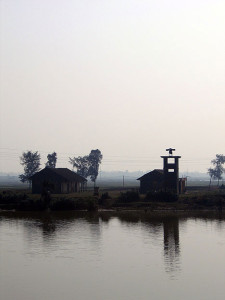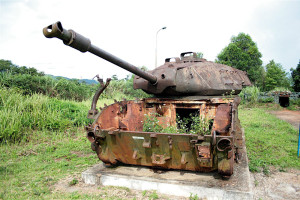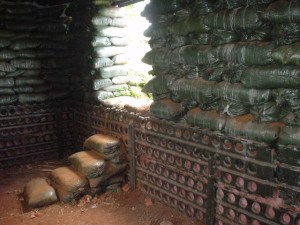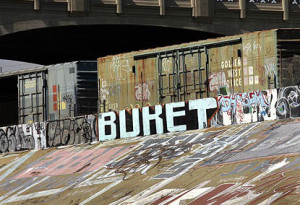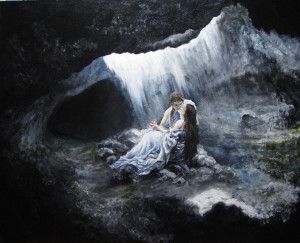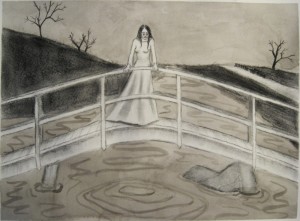
Photo Courtesy of deviantart.com
Drawing by: Psychodelicategirl
In the next three blogs, I will explore different versions of La Llorona stories throughout other cultures and explore why mothers killing children or endlessly mourning their children is such an enduring theme in mythology and literature. To begin, here is an overview of common La Llorona stories from different cultures. I found analogous figures from Greek mythology, the Bible, Aztec myths and in Europe.
La Llorona: While there are variations of the story, the common element is that a woman fell in love with either a noblemen or someone outside her social class and bore his children. Eventually, the man abandons her for someone of a higher social class. In retaliation, La Llorona drowns her children. She haunts water areas looking for the souls of her dead children. She will kidnap children who resemble her dead children or those that disobey their parents, especially by being outside after dark. She is often identified as La Malinche.
La Malinche: Moctezuma sent a group of women as a peace offering to the Spanish conquistadors. Among them was Dona Maria, who quickly proved valuable as an interpreter. Cortes used her knowledge of the land and language to aid in conquering the empire, resulting in her earning the moniker La Malinche (The Traitor). She became his mistress and bore him two children. Myth takes over history, when Cortes is to return to Spain to his wife, taking his sons with Dona Maria with him. She refused to part with her son, fearing losing him either to Spain or at least to the dangerous voyage overseas. She drowned him, to ensure that his spirit would remain in his homeland, because she was afraid his spirit would wander forever. Legend has it that when she died, “God would not allow her through the gates until she returned with the soul of her son. Legend has it that her son’s soul floated away, and she continues to wander the river and its tributaries on a relentless quest (Duarte).”
Cihuacoatl: This Aztec goddess would snatch infants from their cradles and after killing them would roam the streets of Tenochtitlan at night with a mournful wail. Her mournful wail was supposed to foretell war and misery. According to legend, Cihuacoatl appeared shortly before the invasion of Mexico by Cortes. Other version associate her with midwives, and is described as a skull faced woman with eagle feathers in her hair, who carried spears and a shield as a warrior would, to symbolize the act of childbirth as warfare. Other depictions of her are of her face is painted half white and half red, always wearing white. The spirits of those who died in childbirth known as the Cihuateteo, were depicted with skeletal faces like Cihuacoatl. Like her, the Cihuateteo are thought to haunt crossroads at night to steal children (Aragon), (Gomez-Cano). She is considered to be the pre-Columbian version of La Llorona.
Medea: Perhaps the most well-known story of infanticide is that of Medea, who married Greek hero Jason and bore his two children. Jason forsook her and ran off to marry the king of Corinth’s daughter. Out of revenge, she killed Jason’s new bride, the bride’s father and her two children, in order to inflict more pain on Jason (Lindemans). Though La Llorona and Medea both kill their children to spite their estranged husbands, they differ in that Medea shows no remorse for her actions, while La Llorona is eternally weeping and suffering.
Rachel: She was the wife of Jacob, who bore him two sons after a long period of infertility. She dies while giving birth to Benjamin. In the following passage from Jeremiah, she is weeping for her children, who are led into captivity near the spot where she is buried:
Sad-eyed Rachel, do not weep,
Your children die as martyrs go;
They are the first-born of the seed
Which from your blood began to grow;
In spite of tyranny’s dread days
They bloom in glory to God’s praise.
Jeremiah 31:15
Her children’s exile also represents the sadness over the exile of the northern tribes. In Matthew, she weeps again, and this time it represents the sadness she feels over the massacre of the Infants by Herod. Rachel bears some resemblance to Cihuacoatl, because one interpretation of the latter’s tears is that they represent the sadness she feels over the impending conquest of the Aztecs by the Spaniards. In turn, this also parallels Medea in “The Hungry Woman” who grieves over losing her son Choc-Mool to Aztlan (Lang).
Lamia: Lamia was a Libyan princess who had an affair with Zeus. When his wife Hera found out, she murdered her children, turned her into a snake-like monster (other versions are the Lamia’s grief turned her into a monster) and made Lamia unable to close her eyes, so she could not escape the image of her murdered children. Zeus takes pity on her and allows her to remove her eyes and then put them in again. Lamia envied other mothers, so she acts out by stealing their children and then devouring them. This and La Llorona stories are told to children as a way to make them behave. Like La Llorona, she has no respite from her grief over her dead children. There is another version where Lamia is portrayed as a vampire figure; she takes form as a beautiful woman who seduce, then devour men (Lindemans).
Die Weisee Frau (the White Lady). According to legend, Countess Kunigunde was a widow with two children who wanted to marry Albercht von Hohenzollern. After he told her that he would marry her “if it were not for four eyes between them”, the countess mistakenly believed he was referring to her two children (he was actually referring to his parents). She wanted to kill them in way to make it look like they died of natural causes, so she pierced their skulls with a golden needle. She was overcome with guilt and confessed to the pope, who promised forgiveness if she devoted her life to monastic work. She died shortly thereafter. The white lady haunts the castles of the kingdom of Hohenzollern as a malevolent presence, bringing terror to those that cross her path (Duarte).
My next two blog entries will center on the themes that these stories share and their significance. Common threads in each legend include: jealousy, to serve as a warning against misbehavior (sexual and otherwise), as an expression of anxiety over cultural or indigenous displacement, and the way in which historically powerless women subvert the existing power structure in devastating ways.
Works Cited
Aragon, Ray John de. The Legend of La Llorona. 1980.
Duarte, Gloria. “La Llorona’s Ancestry: Crossing Cultural Boundaries.” Untiedt, Kenneth. Folklore In all of Us, In All We Do. Texas: Texas Folklore Society, 2006. 107. e-book.
Gomez-Cano, Grisel. The Return to Coatlicue: Goddesses and Warladies in Mexican Folklore. Xlibris Corporation, 2010.
Lang, David. “Why is Rachel Weeping at Ramah?” 20 December 2012. www.accordancebible.com. 17th March 2014.
Lindemans, Micha. “Encyclopedia Mythica.” March 1997. www.pantheon.org. 2014.
Unknown. The Spirit of La Llorona: La Llorona in Other Cultures. n.d.

